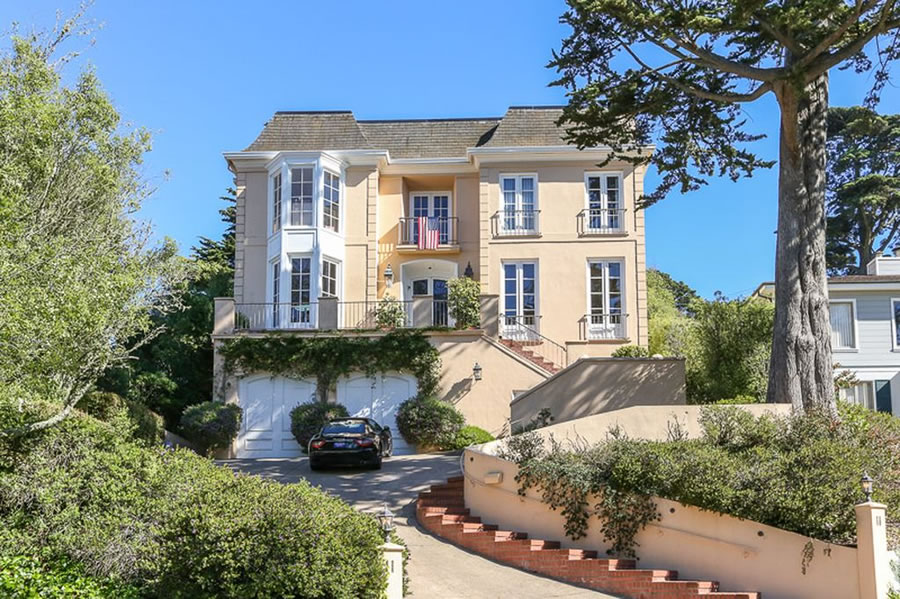Built on a 14,000-square-foot hilltop lot in St. Francis Wood back in 1982, the “French Style Villa Estate” at 11 San Jancinto Way traded hands for $6.25 million in June of 2015.
In addition to “panoramic Pacific Ocean views with breathtaking sunsets and [a] phenomenal outlook to the greenery of St. Francis Wood Upper Fountain Park,” the 6,383-square-foot home features a formal entryway, living room and dining room; a remodeled kitchen, wood-paneled library and four bedrooms; and a two-car garage, two decks and a heated swimming pool, spa and view veranda.
And having quietly returned to the market listed for $6.8 million in 2016, reduced to $6.5 million in 2017, and seeking $5.7 million as of a few months ago, it would appear as though the property has now traded hands with a contract price of $4.6 million or roughly 26.4 percent ($1.65 million) below the price it fetched in the second quarter of 2015.










*Puts fingers in ears* La-la-la-la-la, I cant hear the market tanking. Did you hear FACEBOOK moved to the city? La-la-la-la-la.
Lovely home, although the large pool probably was not a plus for most people. Seems like a pretty good deal.
I live on the poor folks side of Mt. Davidson but we are allowed to drive through SFW. At the time this sold in 2015 we drove by and took a look. The price seemed way too high – even for SFW. I recall talking to some SFW residents and they said the buyers way overpaid. They said 5 million was more realistic. 2015 was the time of irrational exuberance and obviously the buyers were not into realism.
Prices have peaked and are declining in some cases, but no way is the typical SFW home down 26.4% from it’s 2015 price.
“…but no way is the typical SFW home down 26.4% from it’s 2015 price.”
–Not yet.
The couple that bought it are sophisticated, educated people who have lived in San Francisco for over 15 years. One is a doctor who has worked for the city for the last 15 years, the other is a tech CEO of small software companies. They knew exactly what the market was.
They also financed and refinanced, and the bank would have gotten an appraisal, so they’d know if they had grossly overpaid by $3, if the bank would have allowed it at all.
They didn’t over pay by 3 million. If that is what $3, means. Overpaid yes but more like 1.5 million. Irrational exuberance can affect anyone – well paid career person or not.
You never overpay if you actually (just) buy a house because you like it (well I guess you could if it’s some condo or tract and there’s a nearly identical one for less…but that’s seldom the issue on SS).
What I noticed was the flag, proudly – it’s not upside down so it’s not a Trump-related statement – displayed on the railing. If this is a pic snapped during the occupancy of the sellers I’m guessing they sold due to endless harassment from people (tho presumably SFW is more tolerant of such behavior).
Or they saw the writing on the wall and decided to unload at the top of the market. Perhaps trading down to something more affordable, elsewhere
That’s a gorgeous home nonetheless. I never understood why SFW gets so much lower prices than other high-end neighborhoods in SF. It has lots of easy parking, no homeless, no graffiti, close to West Portal Station for getting downtown. The whole neighborhood is walkable and quiet. Best values in the city for larger, luxury homes.
Yes, a very nice and tasteful home. The area is pretty foggy and chilly though. But then again so is the rest of SF. I would love a home in St. Francis Wood
Foggy and chilly are good things in today’s collapsing climate. I will take it!
Not shocking. This house is incredibly bland, uninspired, and dated. It needs a solid investment to satisfy the sensibilities of the average family looking for a house in this price range. When there is a glut in the market, buyers are choosier I suspect the right home with the right characteristics will see a substantially smaller price drop.
See Tipster, above.
I don’t understand the love. It is better than the horrific McMansions profiled on the hilarious McMansion Hell site, but the façade is really oddly designed and awkward.
The home is definitely decorated in a more traditional style while lacking the character of a historic home; nonetheless, it is much more interesting and inviting than the overpriced sterile white box you see typically promoted as a “luxury home” in San Francisco. I would have staged the house differently and steered away from such a peach-colored palette, but I do not think the home’s decorating style is the reason for the fairly large drop in price.
The market is shifting. Moreover the owners seemed to have overpaid even by 2015 standards. While St. Francis Wood has always been an elegant residential enclave, it has never had the cachet of Pacific Heights/Presidio Heights, or any of the other true old-money places. It also lacks the sex appeal of some the currently trendy neighborhoods.
And another completely valid “apple”. 2077 Bancroft in Silver Terrace just sold in October for $1,535,000. Originally sold as new construction for $1,300,000 in May 2016. Completely different neighborhood and price range, but another side to the story. Not claiming the market isn’t slowing or turning, but not all is bleak.
Keep in mind that’s a contemporary single-family home, with 3 bedrooms and 4.5 baths, which just traded for $655 per square foot.
This is a bad outcome. My personal feeling is the owners should have tried to make this house a bit more appealing with some cosmetic updating and better staging. There’s more competition in this market and the interior paint and staging look tragic. But it was like this when they bought it I guess, so…
A market correction is needed and healthy and it’s better to get it over with. A prime Presidio Heights home sold at 16% under list and, while significantly smaller, still traded at a similar price as infamous hoarder and robbery Kendrick’s terrifying and decrepit home a couple of doors down.
I’ll throw out a totally uninformed guess. Based on the last downturn, inventory will continue to climb and likely peak spring 2020, and then will contract as sellers realize they can’t get the price they want and will pull listings from inventory. Prices will continue to decline resulting in a shadow market of off-market homes for sale that won’t be counted in inventory. Construction costs, however, will remain high and long entitled projects won’t be built for another couple of years thus tightening inventory. Fewer projects will likely free up subs, bringing labor costs down a bit. Then maybe we will see an upturn in new development or long delayed development.
Solid take, Denis. Always appreciate your input on these posts.
Remember the liquidity events in the pipeline: “In 2019, expect to see the most American tech mega-listings of any year this century. Uber Technologies Inc., last valued at $72 billion, says it’s planning an initial public offering. Rival Lyft Inc. ($15.1 billion) aims to go public by summertime, and office chat software maker Slack Technologies Inc. expects an IPO valuation north of $10 billion as soon as it can show full 2018 financial results, according to people familiar with the matter. Add to the maybe pile Airbnb Inc. ($31 billion), which a person familiar with the company has said is targeting sometime between June 2019 and the end of 2020.”
Sounds reminiscent of an earlier time… Uber just announced they lost $1B last year.
Didn’t you hear? Bicycles!
Naked Capitalism did a hilarious takedown series on the scam that is Uber. And as more and more people realize that “being your own boss” for Uber and Lyft are scams, their recruiting is getting desperate.
So what? There are secondary markets on which you can trade shares of pre-public companies today. And Uber routinely allows their employees to sell up to $10M during their financing rounds, I suspect other companies do the same. So it’s not like there’s some huge pent up group of sellers just itching to sell who can’t. That money is in the market today, right now. Home prices are falling anyway.
It’s not the employees cashing out stock, it’s the hiring boom brought on by access to public capital.
No, if the IPOs happen, a lot of money will be released. I don’t know about Uber, but most startup employees do not play these early liquidity games or find other ways to hedge pre-IPO, just like most people do not trade options even though there are plenty of books about how to do it.
It’s very possible that the stock market will get uglier and the IPOs won’t happen for years. But saying “that money is in the market today”… I don’t think you understand how much money we’re talking about.
Facebook is trading almost half its price of July. Box is off 30% from last May. Dropbox is half its June price. The same interest rate pressure that is forcing down real estate is forcing down the prices of tech companies. The pre-IPO shares of all those companies were all higher 6 months ago, and when share prices fall, that affects prices.
And there’s no such thing as an “early liquidity game”. Prices are prices, and sometimes the pre-IPO prices are higher than the post.
Most of the money is going to investors, who have been keeping those companies afloat for over a decade. Saudi Arabian home prices might go up.
Yes, we agree that the stock market could easily derail the planned IPOs.
But you have no clue what the cap tables of these companies look like. You can look at Dropbox’s S-1 yourself instead of making it up. What, around a quarter of the shares were owned or owed to non-executive employees? In other words, not owned by investors and not already sold through one of the pre-IPO liquidity arrangements that you claim all the employees are doing.
I’m not claiming they are doing anything. My point is they don’t have to wait for an IPO. They could have sold 6 months ago (and for a higher price) had they wanted.
And lets say I’m completely full of sh*t, and everyone waits to buy real estate until the IPO and they they cash all of it out and pay whatever price the market will bear over the next 6 months. Well guess what, Dropbox HAD its IPO in March and housing prices fell anyway.
It’s not like everyone at Uber is living in a rental, most of the highest compensated employees already have homes and at the IPO will feel no need to buy another one.
Interesting about labor costs being held down a bit. Just as SF has dropped significantly in terms of its position on the crane count list, the contraction worker count (my informal measure) has dropped significantly. That count is based on the Starbuck’s I visit each morning. 2015 – the line at 7AM was almost to the door and half were construction workers. Now there is just a short line with few construction workers. Talking to some of these workers at the time, it turned out many were from out of the area/out of state and temporally here to get a gig on one of the large projects. That job source has been drying up and construction workers are moving onto places high on the crane count such as Seattle and Dallas. As work becomes less easy for those construction workers – more importantly local contractors – who live here to find it should indeed hold labor prices down a bit.
Speaking of under asking, 2100 Broadway, which “represents the finest SF has to offer” and was listed for $17.8 million this past February, has just closed escrow with a $11.6 million contract price.
Stunning home, spectacular panoramic bay views, top location. $1303 psft.
What a bummer for seller..they only made $6m over the time they owned the place. Yea, we all agree real estate is a terrible investment. Keep showing 2015 flips. We can’t get enough.
Place looks completely redone, maybe multiple times. There’s no photos from the old listing, but based on the description, it probably needed lots of cosmetic work and updating.
If you assign $400 psft to remodeling and maintenance over the 19 years, and the purchase price and property tax, it looks like they made under $2M on a 19 year hold. Had they put the purchase price into an S&P fund, they’d have made about $5.6M. So it cost them $3.6M+ to live there (they actually had a mortgage on it for most of the time, now paid off, though who knows how much), and another half mil to sell it, $360K in transfer tax, about $20,000 per month. Not bad, but not $6M of profit, it was actually a fairly sizeable expense to tie that much money up in real estate. The owner was a loaded elderly couple, so I doubt they cared.
Where in your calculation do you account for the money that they would have paid in rent over the period that they owned the place if they had not lived there?
I have no idea what that goes for, maybe $10K/month? That’s $240K/year, or for 19 years is $4,560,000. Obviously time value of money, etc., but still it looks like they sure saved a lot in rent, didn’t they?
In related reasoning, despite having dropped 38 percent over the past four months, or 26 percent over the past year, Facebook stock isn’t actually down because it’s up 200 percent since going public in 2014. Yes, the context matters.
Ugh. Just noticed this was $721 per foot. That’s painful. Was there something wrong with this house that wasn’t apparent in 2015 or didn’t show up in a disclosure?
Maybe it was the “The Watcher.”
This is actually a home that would do well with the dreaded “all-white” interior paint scheme. And a more dramatic exterior color.
Kinda ugly house, to be honest.
If you want to live in a suburb, aren’t there nicer villa suburbs on the Peninsula or Marin?
They would probably cost more…..
Why is this site so obsessed with using over and over and over again certain terms/phrases that carry with them unwarranted implications?
In this article, your headline says both that the property “quietly” traded for 26% less and that it had “quietly” returned to the market in 2016. What do you mean by this? That the owner/broker did this in some surreptitious or sneaky manner, without the fanfare that one would have expected for a typical MLS listing?
A quick search shows that you have used this term 269 times.
What point are you trying to make?
This is just one among many examples of the mind-numbing repetitiveness of the terminology used in your postings. Perhaps time for a little new creativity?
The “Editor” wants to advance his POV. This post will be quickly deleted, just watch. 3-2-1. No debate is tolerated if The Editor disagrees.
And if hope against hope he doesn’t delete this, then ask the real question…are the “apples” truly apples and how well do they represent each SF real estate micro-climate?
And please publish your deletion policy when the comments don’t simply agree with your informed, though clearly biased worldview?
We typically employ ‘quietly’ when a property is on the market or changes hands without being listed/publicized or is actively trying to be obscured or hidden from public view. And apparently we’ve employed ‘quietly’ in around 2 percent of our postings, but thank you for your ongoing concern.
John, you’ve forgot the repeated glee when the website uncovers that–gasp–real estate agents manipulate the process to ensure that properties are sold “over asking”. It’s a shocking discovery that will surely surprise everyone who pays any scant bit of attention to the real estate market. That’s why this expose must be repeated over and over.
But hey, read this one soon before it disappears too.
Having last spiked circa 2007 and into early 2008, our closely tracked WWI™ (Whining and Whinging Index) is once again on the rise. And now back to actual topic and underlying trends at hand…
Talk to the average homebuyer and you will find that a lot of people still focus on the generally bogus metric of sale price vs. asking price. They’re trying to predict the ultimate sales price.
Because this naive attitude is so persistent you can’t blame the editor for continuing to remind readers that “over asking” is meaningless and perhaps employed to influence buyers to frantically overbid. Yeah, longtime readers of this site know it well, but this concept is still worth repeating for the benefit of new readers.
i for one appreciate this kind of information high-lighted by socketsite. otherwise we’re left with only the propaganda from the real estate brokers.
Dear NAR, why are brokers and the industry so obsessed with using over and over: “coveted” and “rarely available” as well as “won’t last long!”? And yes- there is the constant touting of “Over Asking!” and “Multiple Bids!” These phrases and many others commonly used carry with them unwarranted implications.
What’s with consistently having one of the top two lobbying efforts in Washington taking actions that frequently are not in the interest of your clients? What’s with not having standards so that I’ve been in an open house where the agent tells me that two people are preparing bids and the place will be gone in a week and the same agent talks to her co-worker while I”m upstairs and tells her that the place was just re-listed and won’t sell. There are good ethical agents out there. But talk to a potential home buyer who is not in the industry and find out what their experience is when their agent says they will double their money in five years.
There’s the constant cry here about cherrypicking apples and data. The previous buyer overpaid, it wasn’t staged properly, the neighborhood isn’t great, etc. There is an entire industry that skews information the other way so it’s funny that people get so bent out of shape out of one website presenting information that doesn’t fall in line. Whether an apple is representative of the broader market or not, it’s still valuable info and not info that you will get from your broker.
Enough with the can lighting. P.S., this place looks like Natalie’s.